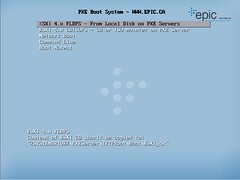Introduction and Requirements– Part 1
Testing and Exporting to vSphere – Part 2
Customising the ESXi Rapid Deployment Server
I couldn't just stop there could I? I decided to make a few alterations to make it a little prettier and hopefully quicker.
Removing some ESXi installation steps which are not required
I'll start off by talking about making some changes to the ESXi installation to help make the deployment a little quicker. I got the idea from Stuart Radnidge's great post; Unattended ESXi Installation. Stu talks about editing one of the Python files that make-up the ESXi installation. Stu has a link to a pre-prepared Install.tgz for you to replace the default Install.tgz that comes in the ESXi ISO. Unfortunately this wouldn't work for me as I was using the ESXi ISO that comes with HP Management Agents so I had to make the changes myself:
Read the rest of this entry »
Introduction and Requirements – Part 1
Customising and Optimising – Part 3
Testing The PXE Boot System
Now that the PXE Server is configured I quickly made a VM in VMware Workstation to deploy ESXi to using the settings in a previous post I wrote.
Here are the steps and settings I used.
- Create a Virtual Machine, Custom
- Workstation 6.5-7.0 Hardware Compatibility
- VMware ESX, ESX Server 4.0
- Number of processors: 1
- Memory: 2048
- Host-Only Networking
- LSI Logic,
- New disc, SCSI
- 30GB, pre-allocated, single file
- Customise hardware, remove: soundcard, USB, floppy – Set execution mode to: IntelVT-x — Customise hardware, add: 5 x Network Adapter’s (Host-Only Networking)
- Edit .vmx and add the following
- ethernet0.virtualDev = “e1000”
- ethernet1.virtualDev = “e1000”
- monitor_control.restrict_backdoor = “true”
PXE Booting the ESXi ready VM displayed the default deployment menu that is shipped with the V-PXEServer application.

Read the rest of this entry »
Testing and Exporting to vSphere – Part 2
Customising and Optimising – Part 3
Introduction
With VMware ESXi looking to be the future of VMware's Hypervisors, we are seeing the end of our beloved Service Console. Like many others I've been beginning to look into how ESXi will be implemented into a Production environment. One of the main area's of interest for me was around setting up a system which would deploy ESXi Hosts.
In the past, when deploying ESX Hosts, I've had the assistance of EDA (ESX Deployment Application), others have also used UDA (Ultimate Deployment Appliance). But due to the absence of the Service Console, scripted installations using Kickstart scripts are now not possible with ESXi.
When looking for a new deployment system to deploy ESXi I was looking for the following requirements;
- Simple Setup – I don't have the time to spend days and days on configuring an application to deploy my Hosts
- Simple Deployment – I want the deployment procedure to be a simple as possible. The deployment of Hosts maybe passed to a team that aren't as accustomed to VMware as I am.
- Quick – I want the deployment of my ESXi Host to be quick, I don't want to have to wait an hour for a Host.
- FREE! – We all love free, espically my CEO.
Read the rest of this entry »

